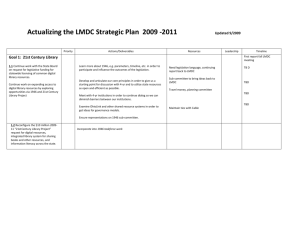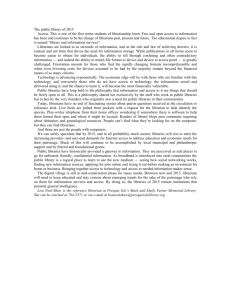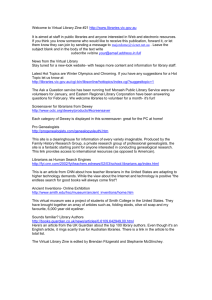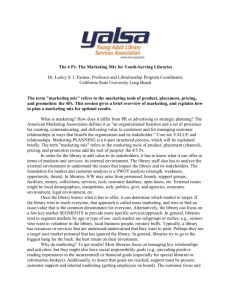070712minutes
advertisement
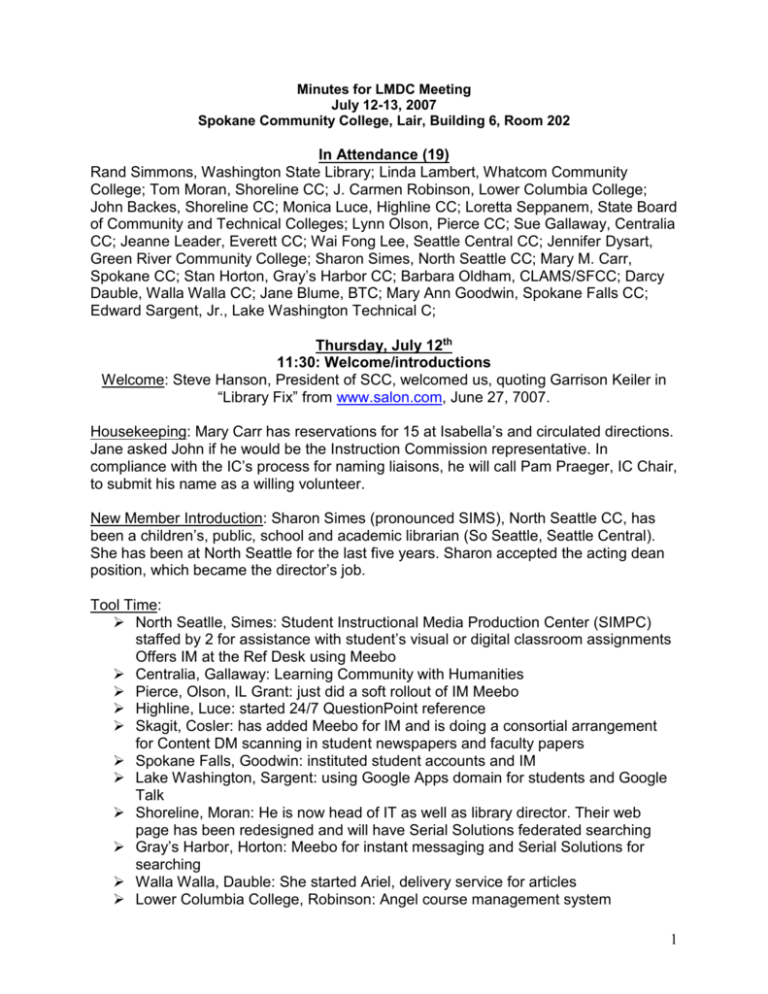
Minutes for LMDC Meeting July 12-13, 2007 Spokane Community College, Lair, Building 6, Room 202 In Attendance (19) Rand Simmons, Washington State Library; Linda Lambert, Whatcom Community College; Tom Moran, Shoreline CC; J. Carmen Robinson, Lower Columbia College; John Backes, Shoreline CC; Monica Luce, Highline CC; Loretta Seppanem, State Board of Community and Technical Colleges; Lynn Olson, Pierce CC; Sue Gallaway, Centralia CC; Jeanne Leader, Everett CC; Wai Fong Lee, Seattle Central CC; Jennifer Dysart, Green River Community College; Sharon Simes, North Seattle CC; Mary M. Carr, Spokane CC; Stan Horton, Gray’s Harbor CC; Barbara Oldham, CLAMS/SFCC; Darcy Dauble, Walla Walla CC; Jane Blume, BTC; Mary Ann Goodwin, Spokane Falls CC; Edward Sargent, Jr., Lake Washington Technical C; Thursday, July 12th 11:30: Welcome/introductions Welcome: Steve Hanson, President of SCC, welcomed us, quoting Garrison Keiler in “Library Fix” from www.salon.com, June 27, 7007. Housekeeping: Mary Carr has reservations for 15 at Isabella’s and circulated directions. Jane asked John if he would be the Instruction Commission representative. In compliance with the IC’s process for naming liaisons, he will call Pam Praeger, IC Chair, to submit his name as a willing volunteer. New Member Introduction: Sharon Simes (pronounced SIMS), North Seattle CC, has been a children’s, public, school and academic librarian (So Seattle, Seattle Central). She has been at North Seattle for the last five years. Sharon accepted the acting dean position, which became the director’s job. Tool Time: North Seatlle, Simes: Student Instructional Media Production Center (SIMPC) staffed by 2 for assistance with student’s visual or digital classroom assignments Offers IM at the Ref Desk using Meebo Centralia, Gallaway: Learning Community with Humanities Pierce, Olson, IL Grant: just did a soft rollout of IM Meebo Highline, Luce: started 24/7 QuestionPoint reference Skagit, Cosler: has added Meebo for IM and is doing a consortial arrangement for Content DM scanning in student newspapers and faculty papers Spokane Falls, Goodwin: instituted student accounts and IM Lake Washington, Sargent: using Google Apps domain for students and Google Talk Shoreline, Moran: He is now head of IT as well as library director. Their web page has been redesigned and will have Serial Solutions federated searching Gray’s Harbor, Horton: Meebo for instant messaging and Serial Solutions for searching Walla Walla, Dauble: She started Ariel, delivery service for articles Lower Columbia College, Robinson: Angel course management system 1 12:00: Working Lunch Technology Transformation Task Force Discussion John Backes reviewed the composition of the Task Force—a large task force with broad representation. The Task Force wants its work to be user driven: What do our citizens want, not what do we want? The group completed a literature review (done by John) which helped fuel a discussion with faculty about their needs. LMDC provided John with a list of questions about possible services which he took to a June 14th meeting. The Task Force has hired a statistician from Washington State University to construct two surveys: one for faculty and one for students. Faculty: The survey will take 10-15 minutes and be composed of 21 questions. John will forward it to us. It contains a series of questions about how we use technology. Libraries are no where in this survey. Questions cover course management; web content, electronic content tools (RSS, podcasting), assessment and communications tools (networking). A statistician will attempt to connect demographics, use, attitude, etc. A presentation will be constructed from this data and focus groups held—at least three—after which a final report will be issued in December 2007. The Student Survey is very brief to encourage them to respond. 1) How do you want to learn? 2) What kind of technology do you want to use? 3) What do you believe about technology? 4) What do you want your college to have? 5) Have you attended a course where your instructor used a content management system? Mindy pointed out that Steve Hiller at UW is pushing libraries and assessment. There is data about how the college experience changes people; now we need to identify how the library experience changes people John will send us the surveys; we are to provide responses to him by July 30th. To develop strategies for libraries, John said that we need to know more about which information resources are used by our students and which are most effective in helping them to succeed. Our reports should include more specific assessment and data collection information. Data should be aggregated so that readers can see information about individual campuses as well as at systems levels. We have to determine what we want for the next three biennia, cost it out, and then make it attractive enough for legislators to move it forward. We will need to work within and outside our colleges to get these services approved. Integrating Library Services into Distance Learning Connie Broughton, who manages distance learning for WAOL, dropped in to ask our opinions about how to integrate library services into course management systems. 2 Twenty-First Century Library Project State Board Report Loretta Sepannen noted that this year every college is getting more FTEs, most of it is targeted funding. Transfer, high-demand (Science, Technology, Engineering, Math— STEM) has new money--$8,700/FTE. Deans are thinking about how to recruit and how to retain student. Includes Workforce High Demand, math at the ECE level, and math for elementary teachers; there is a lot of new money coming into all institutions. We have exceeded the state enrollment quota of 500. The largest high school class is spring 2008. For four years, the number has been mostly the same. The same thing happened in the mid ‘80s. The 25- to 35-year-old group should be growing. The Opportunity Group will be available to every institution, with $1500 extra available per student. Grants are for low income students. Loretta reported that Lower Columbia did a fine job of tracking their IBEST project. The SBCTC has just hired the new person who will do the supplemental budget request. Loretta wants us to be ready to include the core collection of digital resources ($1.5 million). Another topic to consider: how are we going to provide student-driven interlibrary loan? The State Board would like the resources of CTCs to be shared with the 4-year institutions. That would mean that our integrated library management system and other resources would be shared. The state has invested in the baccalaureate institutions working together and has also chosen to work with Oregon; the community colleges in Oregon say that their fees are worth the access to Orbis. Loretta recommends that we ask for info lit and database items because these items will make a difference in the lives of students. Loretta wants our help in educating one of the Governor’s staffers on how libraries are useful. Several LMDC volunteers (Darcy, Mary, and Sharon) will help Loretta craft the language for a supplemental request. Barbara and Mary Ann will do the first draft of a paper. Loretta distributed the Student Achievement Task Force Proposal. Our role in this effort is going to be critical. Colleges should all have an outreach and retention person. Administrators will be focused on the momentum points. We should be talking to them. Council Business Minutes: The minutes of the spring LMDC meeting in Bellevue were seconded and passed. Treasurer’s Report: Mary Carr reported that the balance in the treasury is $6885.60. Dues this year will be $75.00. Motion seconded and passed to accept report. 3 Linda will take a look at the bylaws and propose how support of outgoing presidents will be covered. CLAMS: Barbara Oldham reported on the success of the CLAMS conference. The following issues were covered: censorship, freedom of information, librarians’ open minds, and the Patriot Act. Michael Scroggins appeared surprised that librarians were such freedom fighters. Barbara will continue as president. The offices of vice president and treasurer were filled. It was proposed that CLAMS become a special interest group of ACRL. CLAMS will hold a meeting and a social at Pack Forrest this year. The organization is considering disbanding again. CLAMChowder could remain as a blog; there was concern that leadership by younger librarians isn’t happening and that exposure to directors through LMDC was very positive. Scholarships were extended to library school students. Barbara said that the current balance of CLAMS is around $7000. The bylaws don’t state how remaining funds would be dispersed; it’s illegal to use it for scholarships. Washington State Library Rand Simmons reported the following LSTA ideas which have been prioritized and incorporated into the Library of Council’s work plan: downloadable audio books, funding Teen Advisory Boards, Washington preservation phase II, Generation B, Teaching Teachers about Research. Statewide Vision for Libraries is going to press and will be distributed in August. LSTA five-year plan has been filed with the feds, although there will be minor revisions, so the finished document should be done by September. SDL: ProQuest agreed to four one-year contract extensions at no price increase. WA State Catalog: There will be a series of information sessions. To participate, libraries must subscribe to World Cat, ILL, and First Search. Federal funds will pay the cost of the State Catalog. Prison Libraries: The legislature is not interested in restoring staff for prison libraries. The State Library wants to know if the CTC libraries have prisoner reentry programs. Public libraries are also doing a digital resources request. Report on Information Literacy, LSTA Grant Lynn Olson announced that there will be a meeting on August 20th at Highline. There will also be an all day workshop in October or November during which we will create authentic assessment projects; Olson reviewed the grant deliverables, and distributed documents describing the deliverables. Olson will research the different subject forums/organizations that would be good candidates for IL Immersion participants to present on integrated information literacy projects. Discussion about revising the IL White Paper, a college readiness standard and a transfer readiness standard ensued. Loretta suggested using the “Math Readiness 4 Standards” as a model. Linda agreed to work on the white paper and produce a draft by October-November. Could we use the $175,000 earmarked in the budget to implement an Information Literacy standard similar to the College Readiness Standard through the Washington Center? The need for Simplified Sign-On was discussed. Dauble, Leader and Van Vactor with Bill Storms volunteered to work on explaining this need. IC needs to what the problem is. 4:45 Adjourn followed by tour of Spokane Community College Library 6:00 Dinner at Isabella’s Restaurant and Gin Joint Friday, July 13th LMDC reconvened at 8 a.m. with a continental breakfast, followed by a professional development presentation by Ed Sargent on Library 2.0. His PowerPoint is located at: http://www.slideshare.net/djsarge/library-20-92363/ Library 2.0 characteristics include: Changing our services Technology-driven, but not technology per se Virtual, 24/7 coverage which encourages participation A community-based entity Uses top-notch software which is flexible Judith Cohen, a librarian from Albany, New York has written L2 Manifesto: An Academic’s Perspective: 1. I will educate myself about the information culture of my users and look for ways to incorporate what I learn into library services. 2. I will not be defensive about my library, but will look clearly at its situation and make an honest assessment about what can be accomplished. 3. I will recognize that libraries change slowly, and will work with my colleagues to expedite our responsiveness to change. 4. I will let go of previous practices if there is a better way to do things now, even if these practices once seemed so great. 5. I will not wait until something is perfect before I release it, and I’ll modify it based on user feedback. 6. I will avoid requiring users to see things in librarians’ terms but rather will shape services to reflect users’ preferences and expectations. 7. I will be willing to go where users are, both online and in physical spaces, to practice my profession. 8. I will create open web sites that allow users to join with librarians to contribute content in order to enhance their learning experience and provide assistance to their peers. 5 9. I will lobby for an open catalog that provides personalized, interactive features that users expect in online information environments. 10. I will encourage my library’s administration to blog. We have highly educated people behind the reference desk who are answering questions such as where is the bathroom? How do I log on? One small library dismantled the reference desk, went out into the classroom, became completely involved in instruction, and worked directly with students. Why aren’t we going out and getting people instead of just sitting there? There is the possibility that if all the books went away, nobody would notice. Question: Young people have tuned out email--What would entice people to read a library director’s blog? What are we doing? Monica’s doing some really cool stuff in Library 2.0: blogs, ZoHo office stuff, Google docs links, 24/7 chat, NoodleBib, Google Book Search. Joan Webber’s Yakima Valley College Library is using Library Elf. Jeanne Leader suggests the book Whole New Mind by Daniel H. Pink. Lake Washington Technical uses a one-stop center for weather, notations, Google Apps, email, Google Docs which links back out to other support services. Cost is $10.00 for Google services. The library is part of STAR—Student and Teacher Academics Resource Center. Technologies used in L2 1. RSS 2. Wikis, blogs, blogging, Wikipedia 3. Commentary a d comments functionality 4. Podcasting; personalization & “My Profile” features 5. Personal media such as Podcasting and MP3 files 6. Streaming media audio and video formats 7. Reviews and user driven ratings 8. Personalized Alerts 9. Web Services 10. Instant messaging and virtual reference including co-browsing 11. Folksonomies (people creating their own tags as in LibraryThing, a non linear table of contents, the exact opposite of controlled vocabulary), tTagging, and tag clouds. Plymouth State University, Lamson Library. They make every book a separate page. You can add comments. Amazon uses API. 12. Social networking software 13. Open Access, Open Source, Open Content What does the world need from us? They don’t need us for cataloging. They don’t need us for material. What is our role? There are even tools for evaluating. Why don’t we send out our emails in advance about notification? Second Life has a virtual world for librarians called Info Island. 10:30 -11:00: Work Plan 6 LMDC must develop a plan by spring 2008 indicating what our goals will be, in the 21st Century Library Project. Things to consider: Provision of support for e-learning Determine how to incorporate the library into CMS, distance and hybrid courses CMS Review: determine how to evaluate CMS in relation to the library; write a statement explaining the necessity of the library in CMS for student success and equity of access Simplify sign on (ITPG, Bill Storms at Walla Walla): Determine how library authentication fits in. Darcy, Myra and Jeanne = committee Rewrite technology document by fall Information Literacy Goals Rewrite IL white paper (grant deliverable) Complete current grant and decide on next steps Colleges will assess IL programs using national ACRL best practices Share best practices Assess overall impact of programs at our college at August 20th grant event; Lynn will report back at LMDC Fall meeting Document where our libraries are now compared to the beginning of grant; Libraries will complete rubric again with report back to LMDC at spring ’08 meeting LMDC’s Professional Development plans include a half-day workshop in the fall by the State Board and the adoption of a different communication model, i.e. a blog 11:00 AM: Unfinished Reports from yesterday Distance Learning Council: Mary Ann will report on the two-day meeting which is in two weeks via our new blog. Connie said that there is a new director of E-learning, Cable Green, who will begin on September 17th. There is money for simple sign up, as well as money for a training manager, two projects, and rich media tools (to purchase or license tools that can be shared by all colleges). Connie Broughton presented a one-page professional development opportunity to educate people on WAOL. Self-enrollment is possible and a discussion board is available. SRS training will soon be available. Loretta urges us to set up a classroom. Mindy and Monica will participate. Dates for Upcoming LMDC Meetings: Fall: October 18-19, Tacoma Winter: February 7th-8th, Centralia CC Spring: April 24-25, Walla Walla CC 12:00 PM: Adjourn 7

